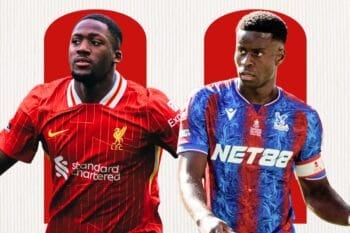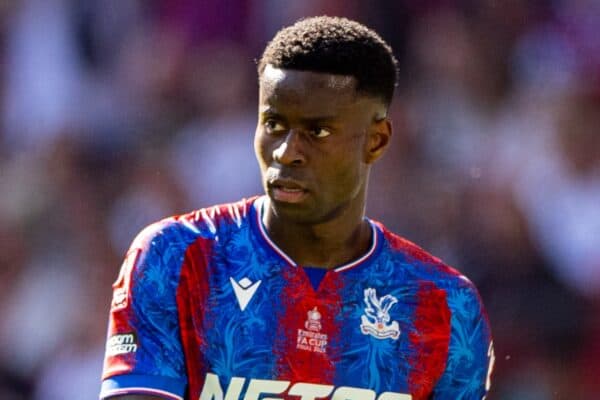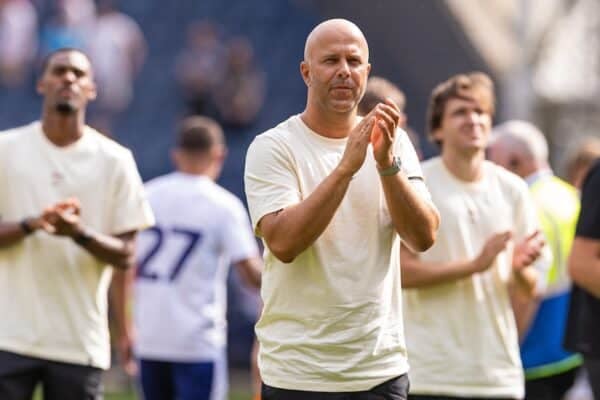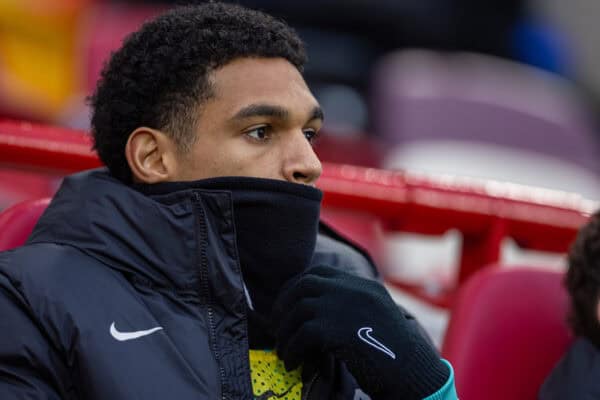Liverpool’s Academy has quite rightly developed a world class reputation since the reforms of Rafael Benitez and Frank McParland were incorporated, becoming the home of some of the best young players in English and European football but has the Reds dedication to excellence jeopardised the progress of those who aren’t involved with the first team?
Liverpool U21s are one of the strongest youth sides in English football. They won the opening group phase by eleven points, conceded the fewest goals – twelve – and were the second highest goal-scorers, hitting the back of the net thirty-one times. Throughout this period they also enjoyed a fourteen game unbeaten run including eleven victories.
On the face of it then, the clubs premier youth team is in good shape and thriving but last Monday’s single goal defeat away to Tottenham Hotspur – the second string’s first defeat in any competition this season – exposed something slightly concerning… a desperate lack of squad depth at U21 level.

Let me start by stating that I acknowledge the squad size of the youth team is hardly the supporters’ primary concern when the first team is equally bereft of numbers and talent. However, in my opinion the two issues are closely linked and this is something I discuss later in the article.
Over the last three seasons, Liverpool made thirty-eight signings under the age of eighteen. In 2009/10 they brought in Raheem Sterling from Queens Park Rangers, Suso from Cadiz and Michael Ngoo from Southend United. The following season Jonjo Shelvey and Danny Wilson were signed for combined fees of £6.7m. With Damien Comolli in charge of transfers for the 2011/12 season, Liverpool captured some of the British Isles most talented young players including Seyi Ojo, Jordon Ibe and Ryan McLaughlin.
This trend of signings, along with several major coaching changes, has seen the Kirkby Academy go from introverted and inefficient to highly respected around the world as a centre of footballing excellence, home to some of the most promising young footballers in the game.
In a pre-season interview the Head of Recruitment, Ian Barrigan, described that the recruitment system worked as a pyramid up until U16s level. At sixteen two top British talents would be added and then at eighteen two top world talents would join with subsequent signings made to fill any holes or weaknesses in the squad. The theory is that this would allow local talent to room and time to develop whilst also ensuring a certain quality is achieved through the signings. It’s a system that was developed and perfected in La Mesia, brought to the club by Borrell and Segura.

The 2012/13 season however, with Pep Segura leaving the club, has seen the Reds distance themselves from this policy having made only one signing for the youth teams, that of Samed Yesil, who was arguably brought in with the idea of fast tracking to first team action anyway and probably would have been more involved were it not for injury.
Has the move away from the policy actually damaged the strength of the academy squads? After all there have been thirty-eight signings in the last three seasons, how many do we need to make? Well seventeen of those thirty-eight signings are still under the age of eighteen, for example Jerome Sinclair has barely turned sixteen, and could not be relied upon for consistent U21 action. Furthermore eight of the players signed in the last three years have now left the club and three players have been called up for first team action on a permanent basis (Suso, Sterling and Wisdom). Therefore just ten of those signings are in reality available for selection, with three of those being goalkeepers.
What is Liverpool’s actual squad strength?
(All of these figures are based on the matches played in Under-21s Premier League Group Stage 1)
In the twelve matches of Group C, Liverpool used 28 players. Four goalkeepers, nine defenders, ten midfielders and five strikers. This was the fewest used by any of the twenty-two teams who averaged a squad size of 36.3 players. If you remove from the equation the players who have now left Liverpool or were simply first team players gaining fitness then the squad size falls to just 20. On top of that if long term injuries such as Samed Yesil and ‘one-off’ U18 call ups are removed then it’s only 16 with four of those being goalkeepers.
That means Liverpool have a selectable, outfield squad of 12 with the league’s average number of outfield players being 31.8, albeit that number can be reduced to around 23 when the same parameters are applied.
What affect does this have on player development?
The knock on effect of having a small squad is significant and not simply about struggling to fill the team sheet on a Sunday afternoon.
Firstly, Liverpool’s U21s are immensely talented – as shown by such a prolific run in the league – but U21 football can only develop players to a certain extent and several members of the squad exceeded the level some time ago. Most notably the players who border the first team such as Jack Robinson, Jon Flanagan and Suso; these players have been on the fringes of Rodgers squad this season and have clearly outgrown the U21s league.
Rodgers is famously quoted as telling Flanagan he was “not Cafu” but at times this season the young Scouser has been able to pass off a decent enough impression because of the relative lack of strength in the league and it’s the same story for Robinson and Suso who simply find the standard to be too easy now. Even beyond them the likes of Conor Coady, Krisztian Adorjan and Stephen Sama are crying out for some first team experience which a loan spell would be perfect for as they are unlikely to break into the first team at this time.

There is, to be fair, a lot to be said for our methods of coaching. As shown by the development of Andre Wisdom and Raheem Sterling, there are paths to the first team that do not require loan spells outside of the club and the expectation is that Jordon Ibe and Ryan McLaughlin will soon be breaking down the first team door and proving the point once again. These players learned enough from the U21 football and our coaches to be able to deal with the demands of Premier League football (or at least potentially could) however, the concern is not for these players.
The early developers are being well looked after, possibly even over-relied on, which is discussed later, due to the famous ‘fast-track’ system but those players who develop slightly later, in positions requiring more tactical awareness and nous than the average seventeen year old is blessed with appear to be overlooked and forgotten.
Here lies the first, and major, problem of Liverpool’s small squad size. It simply isn’t feasible for certain players to leave on loan because we couldn’t afford to lose that player. Conor Coady, for example, if he was to arrange a loan spell away from the club the knock on effect would be that Jordan Lussey would progress to the U21 team – no issue there, Lussey is a talented midfielder and nearly at the right age anyway – but in turn Lussey would need replacing at U18 level so most likely fifteen year old Jordan Rossiter would be the boy called upon to play three years above his age group.
While Rossiter’s cameos at U18 level have been encouraging it is too much to expect him to play so far ahead of his age level week in week out and continue to develop in such a consistent manner. Different players develop at different rates and simply throwing young players into the higher age category doesn’t mean they are being properly graduated and it may not be beneficial for them given the increased exposure on LFCtv and therefore fan pressure or simply the confidence knock they may receive if someone three years older than themselves physically and mentally bullies them.

So loan spells are difficult to come by at Liverpool at the moment; only Michael Ngoo, Dani Pacheco, Danny Wilson and Jamie Stephens have managed to secure long term moves to other clubs and it appears to be working well for at least two of the lads – Ngoo and Wilson earning rave reviews at Hearts. It would be nice to offer such opportunities to the likes of Coady and Adorjan but it now seems unlikely either will get that chance this season. Both turn 21 next year and the club will have to either register them as first team players or sell them for the 2014/15 season – if they haven’t had any first team action by then they will certainly not be at a level required to take up one of the 25 man slots.
A lot of people may well read this and think “they aren’t good enough anyway”. This may be true they both certainly have their limitations but equally the huge improvement in form of Coady following his permanent move to Melwood earlier this season is an encouraging sign that he has room to grow where he had previously looked stale and incapable of further progress. Some players just need that experience of first team football to allow them to push on another 15-20%.
Some will have successful loan periods and return a better player, like Martin Kelly, others will have unsuccessful ones and never get to the level required like Nathan Eccleston or David Amoo but if we as club are unable to offer such opportunities then we will be writing off anyone who isn’t a superstar by the age of 18 and that is a worrying situation in my opinion.
What can be done about it?
Contrary to what you probably believe I’m about to say, I am not going to start demanding the club sign seven or eight eighteen year olds at a substantial transfer fee to the detriment of the first team. Quite the contrary, I believe it is the first team squad which is ultimately hurting the U21s.
At the age of eighteen years, two months and eight days Raheem Sterling has made thirty-eight appearances for club and country this season and it’s not even March. At the same age, Lionel Messi made eight appearances for Barcelona. Andre Wisdom has played twenty-four times, Lilian Thuram at the same age played just once. Suso so far has made twenty-six appearances; at his age, David Silva hadn’t even made his debut.
The above comparisons, which are in no way meant to compare the ability of the players, are to make two points. Firstly, that Liverpool are clearly over-reliant on young players. There is no way a player only just turned eighteen should be making thirty-eight appearances in a season, never mind in little over half a season. Secondly, just because you don’t make regular appearances when you’re still in nappies it does not mean you aren’t going to go on and develop into a world class footballer.

If Liverpool’s first team had some depth then we would have been able to use the likes of Sterling, Wisdom and Suso – but used them sparingly – we could give ourselves tantalising looks at the future without becoming overly reliant and in the meantime they could have still turned out for the U21 sides, bringing back with them a little more experience everytime and squad depth to allow those who couldn’t get action quite yet to leave and find football elsewhere on loan. Sure, we’d still have needed one or two more players at U21 level to cover for positions such as centre back where the club are desperately short but mainly the signings to help solve the problem of the U21s needs to happen at first team level.
If Maxi Rodriguez had stayed, for example, we would have been able to rest Sterling more often which in turn might have allowed Adorjan to find a loan club this season which would surely have been more beneficial to him. Sterling would still have got first team game time but dropping in and out would reduce the substantial pressure on his young shoulders.
In previous years the club has found itself top-heavy, we had drifters such as Milan Jovanovic and Philipp Degen taking up squad positions that were utterly unnecessary and acted as a brick wall to the youngsters in the Academy.
We now find ourselves in the exact opposite position, we are too thinly spread at first team level and the affect has been to form another, more curious, barrier and that is the one where players are forced to stay with the first team when occasionally playing for the second string may be better for them and where second string players are forced to stay with them in order to help fill a team sheet when going out on loan would probably help them.
It’s a work in progress, Liverpool have got the transition wrong, but it was always likely to go too far the other way at some point. What is important is that the people who are paid to see these problems can fix them.
We need to return to the policy of buying in the best British youngsters and simultaneously we need to make sure the first team has enough players to function on its own. Breaking in young footballers is a lengthy process that requires timing and patience – relying on them from a young age just hurts everybody.

















Fan Comments